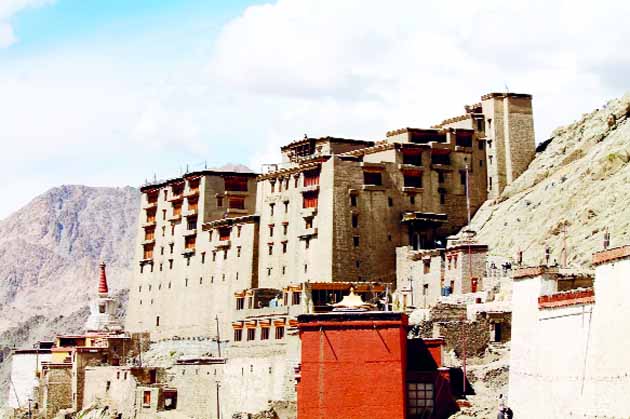Rammed Earth Technology Saviour of Ladakh heritage sites

By Colonel Satish Singh Lalotra
‘Our heritage is not a document, it is a living tradition’—anonymous.
A heritage precinct means and includes any space that requires conservation and/or preservation for historical and/or architectural, aesthetic, cultural, environmental or ecological purposes.
Heritage site goes with the concept of inclusion of any building of one or more premises or any part thereof which requires conservation and preservation for the above mentioned purposes.
There could be a single cause or a multitude of such causes that may prompt the experts of this field to roll up their sleeves to get going. In India, the first instance of record of conservation dates back to Emperor Ashoka’s time when he ordered to conserve wildlife in 3rd century BC.
Thereafter beginning in the 14th century AD, Firauz Shah Tuglaq ordered to protect ancient buildings. Come the British raj and we have had various resolutions passed viz ‘the Madras regulation(VII) which was passed in 1817 , the Bengal regulation ( XIX) of 1810 and so on that lay emphasis on government intervention whenever the public buildings were under threat of misuse.
The year of 1863 saw ‘Conservation act XX’ passed which authorized the government to prevent injury to and preserve buildings remarkable for their antiquity or for their historical or architectural value. However many historical buildings and structures were destroyed by the government that dates back to pre-independence days.
Be that as it may, it would be well understood by a reader of this article that howsoever stringent measures may be set rolling by the governments of the day, ultimately the biggest single factor that saves a heritage building for posterity from both the human as well as elemental depredations is the robust architectural design, technology and material used for the said heritage site.
A similar sort of saga combining myriad facets of human intellect, technology, single mindedness, innovativeness and such like qualities had manifested for hundreds of years in the northern frontiers of our country, notably the Himalayan region that bespoke of architectural grandeur of the region’s magnificent buildings.
Spearheading the above was the age old ‘Rammed earth technology’ that had been holding centuries old forts, monasteries and such like structures intact even to this day.
Having had many opportunities in my service career to witness such marvelous structures ranging from Ladakh to Sugar Sector ( Kinnaur of HP) and even neighbouring Uttrakhand employing this centuries old technology put out any misconceptions in my mind regarding the qualities of inhabitants of these areas when it came to care and preservation of their heritage sites.
Though this typical ‘Rammed earth technology’ has been made the seminal use of by the architects of yore in historical places like the world famous ‘Tabo monastery’, the world heritage site of ‘Hemis gompa’ now a UNESCO recognized heritage site, Shey monastery, Tikse monastery etc; I am laying stress in this write up on one of the most iconic heritage sites of Ladakh that strikes the eyes of a traveller even before he or she has landed on the terra firma of this cold desert.
The ‘Leh palace’ also called as ‘Lechen Palkhar’. Visible from the air miles away this imposing nine-storeyed 17 th century grandiose human testimony to the world at large comes into its grandeur best when the aircraft takes the final turn for its landing at Leh airport.
It takes some time for the human faculties of seeing and absorbing the enormity of this palace to sink in. I have had few chances to see this palace while posted in Siachen glacier moving up and down from Leh to Thoise on sundry official duties.
Perched high on a hill, the structure looms over the Leh town’s temples, mosques, and houses like a colossus. Over the years, the familiarity of this visual image has become legendary, as it is the main subject of numerous sketches, paintings and photographs of the area.
Leh was particularly well served by a stream of European travellers, sportsmen, army officers, diplomats and missionaries. They came here frequently with their box like cameras, and glass plates and chose the same views—the dramatic picture of the town, palace, and the castle from the ‘Lhato’ hill to the south.
At the time when it was built, it was the highest building in the Himalayas -until the construction of the 13 storey high ‘Potala palace’ in Lhasa a few years later.
The palace of Leh antedates that of Potala and is on a much modest scale; but essentially the two buildings are same in tradition. Domestic architecture too is an expression of similar canons of style, though adapted to a different function.
Now what exactly is the ‘Rammed earth technology’? It is basically a construction technique for constructing foundations, floors, and walls using compacted natural materials such as chalk, earth, lime or gravel.
It is an ancient method that has been revived recently as a sustainable building material. Under its French name of ‘Pise’ it is also a material for sculptures, usually small and made in molds. It has been especially used in central Asia and Tibetan art and sometimes even in China.
Making rammed earth involves compacting a damp mixture of sub-soil that has suitable proportions of sand, gravel, clay, silt and stabilizer if any into a formwork. Historically lime or animal blood was used to stabilize it.
Soil mix is poured into the framework to a depth of 10 to 25 cms and then compacted to approximately 50% of its original volume. The soil is compacted iteratively, in batches, or courses so as to gradually erect the wall up to the top of the frame work.
Tamping was historically done with a long ramming pole by hand, but modern construction systems can employ pneumatically -powered tampers.
After a wall is complete, it is sufficiently strong to immediately remove the formwork. This is necessary if a surface texture is to be applied for example by wire brushing, carving or mold impression because the walls become too hard to work after approximately one hour.
The compressive strength of rammed earth increases as it cures. Cement -stabilized rammed earth is cured for a period of 28 days.
Rammed earth can contribute to the overall energy efficacy and efficiency of the edifices: the density, thickness and thermal conductivity of rammed earth can contribute for passive solar heating too.
In the case of this Leh palace, the rammed earth technology has been used with the outer walls of the palace having a considerable slope, as their thickness diminishes rapidly with their increase in height. The visual texture of the wall faces comes about from the way the stones have been laid.
The majority of the wall faces show random texture but a few have a distinct, banded texture. This banded texture is deliberately created by first using a set of large stones in a row, best aces forward, then using small stones to pack the spaces in-between them and to form a leveling layer for the next row of large stones.
Another interesting technique is the use of timber lacing of walls, a technique commonly used in many parts of the world including the Himalayas – from Hunza to Nepal.
But at the time of my two odd visits to this unique palace in 1996 while on my R&R (Rest & refit), I couldn’t fathom the uniqueness of this rammed earth technique. Similarly on my next sojourn with the famous ‘Tikse monastery’ on the banks of river Indus I found a strikingly similar construction technique in place.
Surprisingly even the world famous ‘Tabo monastery’ in Lahul- spiti valley depicts the same rammed earth technology. It was only in the later years of my service that I laid hands on the various texts covering this unique construction methodology that has been the mainstay of such historical places spanning from Ladakh to Arunachal Pradesh.
In the summer of 1834, Maharaja Gulab singh of Jammu & Kashmir declared war on Ladakh and sent his redoubtable General Zorawar Singh to capture this region.
The Dogra invasion succeeded ended the ‘Namgyal dynasty’ which lost its sway of centuries over the area. The last king of independent Ladakh was ‘Tsepal Migyur’ ,also known as ‘Tsepal Namgyal’ who ascended the throne in 1792.
But as mentioned above he was deposed by the Dogras in 1834, and by 1837 he had moved out to his new abode in ‘Stok’ across the river Indus from Leh where his descendants still live.
With the king having gone out of Leh it was as if the light had been extinguished from the lives of the Ladakhis. Other residents too moved out of Leh further below the palace that was developing at a much faster rate than the earlier one near the palace.
In 1991 the palace was taken over by the ASI (Archeological survey f India). In 1995 the ASI started its renovation plans and works with some initial repairs to the structure. It was way back in January 1996 when on my pay collection for the unit from SBI Leh as adjutant from the base camp of Siachen glacier that I happen to visit this palace, though it was then more than 2 feet under snow.
Then in 1998, the ASI began its major repairs and renovation work. Today Leh palace is a much sought after on the itinerary of an avid traveller. Visitors throng it round the year to have a typical bird’s view of the town of Leh.
Alexander Cunningham provided one of the first detailed versions of this palace in 1854. I believe lots of water has flown down the river Indus to turn back the clock dating back to the ‘Great Game’ days when places like Leh and beyond including, Gilgit, Chitral, Hunza etc called the shots whose reverberating booms could be heard in the corridors of power from London to Calcutta.
Nevertheless, the need to conserve these places is imperative for our own markers of identity which can only be ignored at the peril of our future generation. As someone has rightly said— ‘Our heritage is not a document, but a living tradition’.



